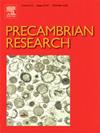Review of Paleoproterozoic tectonics in the southern West African Craton: Insights from multi-disciplinary data integration
IF 3.2
2区 地球科学
Q2 GEOSCIENCES, MULTIDISCIPLINARY
引用次数: 0
Abstract
For over a century, research has focused on the southern West African Craton (sWAC), aiming to unravel its lithological, geochemical, geochronological, structural, metamorphic, and metallogenic record. Yet, the late Siderian to early Rhyacian (c. 2350–2265 Ma) geodynamic setting of the sWAC remains poorly constrained due to (i) the unresolved configuration of adjacent Archean blocks; (ii) limited geochronological data for the lowermost stratigraphic units; and (iii) extensive overprinting by subsequent magmatic, tectonic, and thermal events. Using a multidisciplinary data integration approach, it is however possible to conduct the analysis of tectonic processes governing the emplacement of the Paleoproterozoic granite-greenstone belts of West Africa.
In this review, we integrate all available published datasets and knowledge to provide new insights on the late Siderian to Rhyacian tectonic evolution of the sWAC. This data compilation is presented and discussed in the form of key time slices (c. 2350–2265 Ma, 2265–2200 Ma, 2200–2135 Ma, 2135–2120 Ma, 2120–2095 Ma and 2095–2060 Ma), which mark evolutionary stages in the geological history of the region. The results of our analysis support the shift from enigmatic Archean tectonic modes to plate tectonics, with the onset of subduction at c. 2265 Ma.
However, critical knowledge gaps remain, particularly regarding the tectonic significance of greenstone belts and the role of the West African Craton in potential configurations of the Eburnean–Transamazonian Orogen during the assembly of Nuna. To address these issues, future research directions are proposed to conclude this synthesis.
西非克拉通南部古元古代构造研究进展:多学科数据整合的启示
一个多世纪以来,研究一直集中在西非克拉通南部(sWAC),旨在揭示其岩性、地球化学、地质年代学、构造、变质和成矿记录。然而,由于(1)相邻太古宙地块的未解构造,sWAC的晚Siderian至早Rhyacian (c. 2350-2265 Ma)地球动力学背景仍然没有得到很好的约束;(ii)最低层地层单位的有限年代学资料;(iii)随后的岩浆、构造和热事件造成的大面积叠印。然而,利用多学科数据整合方法,可以对控制西非古元古代花岗岩-绿岩带侵位的构造过程进行分析。在此综述中,我们整合了所有已发表的数据集和知识,以提供对西南海相晚西德世至晚Rhyacian构造演化的新认识。这些资料以关键时间片(约2350-2265 Ma、2265-2200 Ma、2200-2135 Ma、2135-2120 Ma、2120-2095 Ma和2095-2060 Ma)的形式呈现和讨论,这些时间片标志着该地区地质历史的演化阶段。我们的分析结果支持从神秘的太古宙构造模式到板块构造的转变,在约2265 Ma俯冲开始。然而,关键的知识差距仍然存在,特别是关于绿岩带的构造意义和西非克拉通在努纳聚集期间埃伯内-跨亚马逊河造山带的潜在配置中的作用。针对这些问题,提出了未来的研究方向,以完成本文的综合研究。
本文章由计算机程序翻译,如有差异,请以英文原文为准。
求助全文
约1分钟内获得全文
求助全文
来源期刊

Precambrian Research
地学-地球科学综合
CiteScore
7.20
自引率
28.90%
发文量
325
审稿时长
12 months
期刊介绍:
Precambrian Research publishes studies on all aspects of the early stages of the composition, structure and evolution of the Earth and its planetary neighbours. With a focus on process-oriented and comparative studies, it covers, but is not restricted to, subjects such as:
(1) Chemical, biological, biochemical and cosmochemical evolution; the origin of life; the evolution of the oceans and atmosphere; the early fossil record; palaeobiology;
(2) Geochronology and isotope and elemental geochemistry;
(3) Precambrian mineral deposits;
(4) Geophysical aspects of the early Earth and Precambrian terrains;
(5) Nature, formation and evolution of the Precambrian lithosphere and mantle including magmatic, depositional, metamorphic and tectonic processes.
In addition, the editors particularly welcome integrated process-oriented studies that involve a combination of the above fields and comparative studies that demonstrate the effect of Precambrian evolution on Phanerozoic earth system processes.
Regional and localised studies of Precambrian phenomena are considered appropriate only when the detail and quality allow illustration of a wider process, or when significant gaps in basic knowledge of a particular area can be filled.
 求助内容:
求助内容: 应助结果提醒方式:
应助结果提醒方式:


